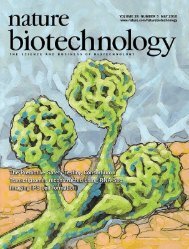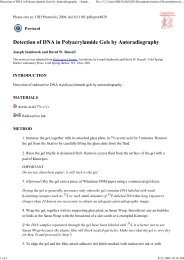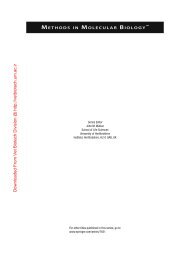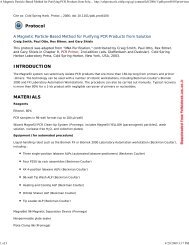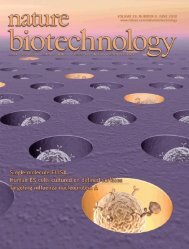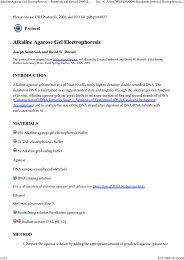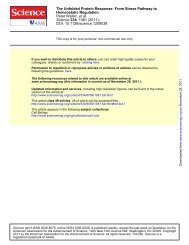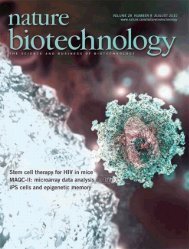Ontology engineering
Ontology engineering
Ontology engineering
You also want an ePaper? Increase the reach of your titles
YUMPU automatically turns print PDFs into web optimized ePapers that Google loves.
l e t t e r sRFP-NLS-IPSEGFP-IPSIRR CD81 –RFP-NLS-IPS+IRRRFP-NLS-IPS+CD81 –cWT+DMSOWT+2′CMAC508Y+DMSOab+HCVcc–HCVccCo-culture© 2010 Nature America, Inc. All rights reserved.MergeEGFP-G3BPRFP-NLS-IPS32 32.5 33.5 34.5 36.5 37 39.5 48Figure 3 Use of the IPS-1-based reporter to expand HCVcc culture systems. (a) Co-culture of spectrally distinct HCV reporter cell lines for visualizingCD81-independent infection. Wide-field fluorescence images of unfixed mono- and co-cultures of Huh-7.5 cell lines expressing RFP-NLS-IPS orEGFP-IPS in the presence (+HCVcc) or absence (−HCVcc) of J6/JFH clone 2. EGFP-IPS cells stably express shRNA targeting CD81 (CD81 − ) or anirrelevant sequence (IRR). Monocultures were infected for 72 h before imaging. In co-culture experiments, RFP-NLS-IPS cells were infected withHCVcc for 36 h before mixing with uninfected EGFP-IPS/IRR or EGFP-IPS/CD81 − cells. Co-cultures were incubated for an additional 48 h beforeimaging. (b) Multiplexing the HCV reporter with a marker of the stress response. An Huh-7 cell line expressing RFP-NLS-IPS and an EGFP-taggedstress granule marker (EGFP-G3BP) was infected with Jc1FLAG2(p7-nsGluc2A). Live-cell imaging was initiated at 6 h post-infection with imagescaptured every 30 min. Montage shows selected time points beginning at 32 h post-infection; times (h) from the start of infection are indicated.See Supplementary Videos 2a–c. (c) Visualization of HCVcc infection in primary hepatocytes. Primary human hepatocytes maintained as MPCCswere transduced with lentiviruses expressing wild type (WT) or mutant (C508Y) RFP-NLS-IPS. At 24 h post-transduction, MPCCs were infectedwith Jc1FLAG2(p7-nsGluc2A). After 12 h, virus was removed and MPCC medium containing DMSO or 2′CMA was added. Unfixed MPCCs wereimaged by wide-field fluorescence microscopy at 48 h post-infection. Representative phase contrast (top row) and corresponding RFP fluorescenceimages (middle row) are shown. Enlarged fluorescence images (bottom row) correspond to area denoted by white dotted box (middle row). The numberof cells per MPCC island exhibiting nuclear RFP at 48 h post-infection is plotted for each condition. For WT RFP-NLS-IPS+DMSO, n = 40;WT RFP-NLS-IPS+2′CMA, n = 30; C508Y RFP-NLS-IPS+DMSO, n = 35. Bar, mean number of positive cells/island. Scale bars, 20 µm (a and b),200 µm (c, top row), 10 µm (c, lower row).Infected cells/island (number)1614121086420WT+DMSOWT+2′CMAC508Y+DMSOdifficulties, and explored its use for detecting HCV infection inthe recently developed micropattern co-culture (MPCC) system 26 .MPCCs consist of primary adult human hepatocytes seeded onislands of collagen and surrounded by mouse fibroblast ‘feeder’ cells.These conditions allow hepatocytes to be maintained for extendedperiods without the rapid decline in cellular functions seen in conventionalmonocultures or random co-cultures 27 . To visualize HCVinfection in MPCC hepatocytes, we transduced cultures with RFP-NLS-IPS or RFP-NLS-IPS(C508Y) and infected them 48 h later withJc1FLAG2(p7-nsGluc2A), allowing MPCC infection to be monitoredin parallel by Gaussia luciferase secretion 28 (SupplementaryFig. 3). MPCC islands were examined by live cell microscopy and thecells per island exhibiting nuclear RFP were enumerated (Fig. 3c).In cultures transduced with RFP-NLS-IPS followed by DMSO treatment,~98% of the islands observed contained cells with nuclearRFP, averaging four cells/island. In the RFP-NLS-IPS populationtreated with 2′CMA, only 6% of islands exhibited infected cells,corresponding to an average of 0.06 cells/island. Cells transducedwith RFP-NLS-IPS(C508Y) did not show nuclear RFP in any of theislands examined (Fig. 3c). These results indicate that infection ofprimary hepatocytes can be readily detected using the HDFR system.To our knowledge, visualization of HCV infection in live primaryhepatocytes has not been demonstrated previously.Although systems for tracking HCV replication in culture haveexpanded rapidly in recent years, robust detection methods applicableto imaging of individual live cells have not been available. Wedescribe a sensitive HCV reporter that allows easy distinction ofinfected and uninfected cells in live or fixed cultures by standardfluorescence microscopy. The robust signal of the reporter systemderives from the efficiency of NS3-4A cleavage and the constitutivehigh-level expression of the substrate; nuclear translocation increasesvisualization, as the reporter becomes concentrated in a region withlow autofluorescence, a particular advantage when working withhepatocytes. Although reporter cleavage does not occur in the absenceof an active protease, transient signal may be expected in the presenceof a polymerase inhibitor—this high sensitivity may have to befactored in as ‘background’ for some applications. The HDFRsystem does not require genetic modification of the viral genome andshowed efficient detection of all HCV genotypes tested. This raisesthe possibility of using the reporter to identify novel infectious isolatesdirectly from patient samples, potentially expanding the HCVccsystem beyond the currently available genotype 2a strain. Coaxing170 VOLUME 28 NUMBER 2 FEBRUARY 2010 nature biotechnology




